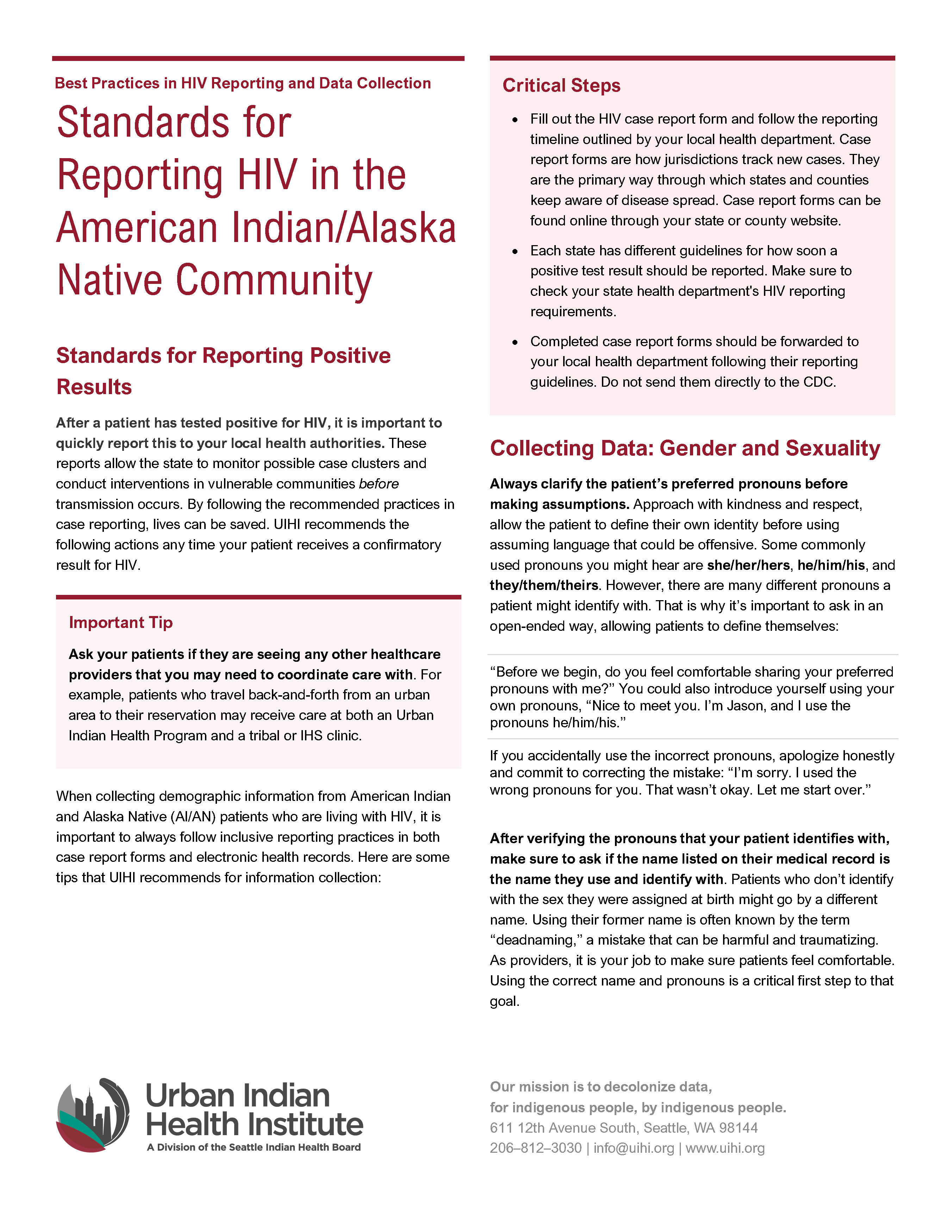Standards for Reporting Positive Results
After a patient has tested positive for HIV, it is important to quickly report this to your local health authorities. These reports allow the state to monitor possible case clusters and conduct interventions in vulnerable communities before transmission occurs. By following the recommended practices in case reporting, lives can be saved. UIHI recommends the following actions any time your patient receives a confirmatory result for HIV.
Important Tip:
Ask your patients if they are seeing any other healthcare providers that you may need to coordinate care with. For example, patients who travel back-and-forth from an urban area to their reservation may receive care at both an Urban Indian Health Program and a tribal or IHS clinic.
When collecting demographic information from American Indian and Alaska Native (AI/AN) patients who are living with HIV, it is important to always follow inclusive reporting practices in both case report forms and electronic health records. Here are some tips that UIHI recommends for information collection:
Critical Steps
- Fill out the HIV case report form and follow the reporting timeline outlined by your local health department. Case report forms are how jurisdictions track new cases. They are the primary way through which states and counties keep aware of disease spread. Case report forms can be found online through your state or county website.
- Each state has different guidelines for how soon a positive test result should be reported. Make sure to check your state health department's HIV reporting requirements.
- Completed case report forms should be forwarded to your local health department following their reporting guidelines. Do not send them directly to the CDC.
Collecting Data: Gender and Sexuality
Always clarify the patient’s preferred pronouns before making assumptions. Approach with kindness and respect, allow the patient to define their own identity before using assuming language that could be offensive. Some commonly used pronouns you might hear are she/her/hers, he/him/his, and they/them/theirs. However, there are many different pronouns a patient might identify with. That is why it’s important to ask in an open-ended way, allowing patients to define themselves:
“Before we begin, do you feel comfortable sharing your preferred pronouns with me?”
You could also introduce yourself using your own pronouns, “Nice to meet you. I’m Jason, and I use the pronouns he/him/his.”
If you accidentally use the incorrect pronouns, apologize honestly and commit to correcting the mistake: “I’m sorry. I used the wrong pronouns for you. That wasn’t okay. Let me start over.”
After verifying the pronouns that your patient identifies with, make sure to ask if the name listed on their medical record is the name they use and identify with. Patients who don’t identify with the sex they were assigned at birth might go by a different name. Using their former name is often known by the term “deadnaming,” a mistake that can be harmful and traumatizing. As providers, it is your job to make sure patients feel comfortable. Using the correct name and pronouns is a critical first step to that goal.
It’s important to understand the differences between sex assigned at birth, gender identity, and sexual or romantic orientation. Including this information in a patient’s medical chart can go a long way in building trust and comfort. Additionally, discussing sexual orientation and gender identity with patients can help determine the need for STD testing, including the anatomical sites to collect specimens for testing. Within the definitions below are some of the responses you might hear.
Sex assigned at birth is the sex assigned based on body parts, chromosomes, and hormones that a person presents at birth. Examples include male, female, intersex, etc.
“To provide the best care, it’s important that we understand your anatomy. What sex were you assigned at birth according to your official birth certificate?”
Gender identity is how a person feels inside and how they visualize themselves and their gender. It is regarded as a person’s innermost understanding of who they are. Examples include male, female, non-binary, cisgender, Two-Spirit, transgender, genderqueer, gender fluid, etc.
“If you feel comfortable sharing with me, I would like to ask you what gender you identify as.”
Sexual and/or romantic orientation is defined by whom a person finds themselves romantically or sexually attracted. Examples include straight, gay, lesbian, bisexual, pansexual, TwoSpirit, asexual, etc.
“In order to ensure you get the best care, we want to get the fullest picture of your medical history. Do you typically have sex with males, females, both, or neither?”
Race, Ethnicity, and Tribal
Always ask the patient how they identify, never make assumptions. If patients identify as more than one race, list all, if space allows.
UIHI recommends that providers avoid options such as “two or more” in the collection of race data. This often leads to racial misclassification of AI/AN people and makes disaggregating data difficult.
Include tribal affiliation information if space allows.
The information in this document came from the Centers for Disease Control and Prevention’s HIV and Perinatal HIV Exposure Reporting Case Report Forms.

